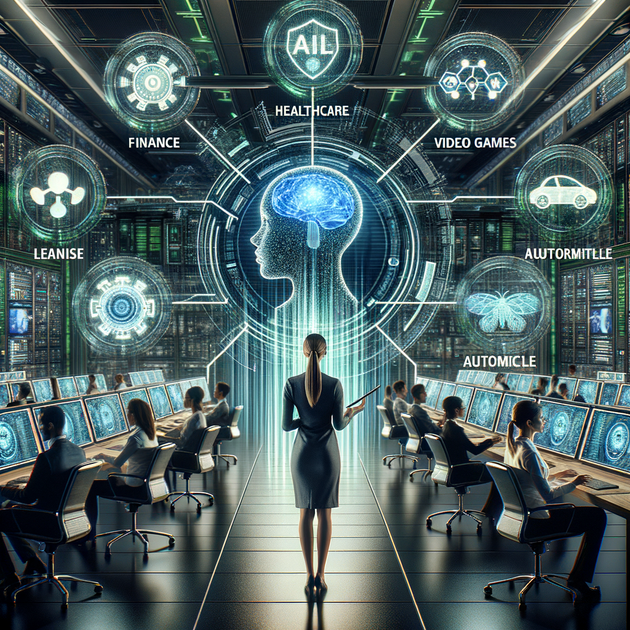Nvidia’s AI Revolution: Crafting the Future with Cutting-Edge Supermodels
Imagine a world where AI models are custom-tailored to meet the unique needs of every business. Nvidia is making this a reality with its latest breakthrough in AI technology: the “supermodel.” This innovation merges state-of-the-art AI techniques to create finely-tuned models that deliver unmatched performance and accuracy. Strap in as we delve into Nvidia’s vision for the future of AI.
The Emergence of the “Supermodel”
Nvidia has always been at the forefront of AI advancements, and their latest endeavor introduces the concept of a “supermodel.” But what exactly does this mean? At its core, the supermodel is a combination of multiple large language models (LLMs) fine-tuned to create an AI application that precisely fits customer requirements.
Nvidia’s innovation leverages Meta’s new Llama 3.1 AI model with 405-billion parameters, integrated with Nvidia’s own model, Nemotron. Together, they form the backbone of the AI supermodel.
The Dynamics of the Supermodel: Llama 3.1 and Nemotron
Nvidia’s supermodel strategy is much like a good cop-bad cop routine. The Llama 3.1 provides initial outputs, which are then scrutinized by Nemotron for quality assurance. This iterative process ensures the output is fine-tuned for accuracy and relevance, resulting in more reliable AI responses.

This innovative model-building process involves creating synthetic data and utilizing reward systems to enhance AI responses. Kari Briski, a vice president at Nvidia, highlights the essence of this approach, stating, “You can use those together to create synthetic data. So … create synthetic data, and the reward model says yes, that’s good data or not.”
The Advantages of Customized AI Models
The beauty of Nvidia’s supermodel isn’t just in its intricate design but also in the benefits it brings to businesses. Customized AI models can significantly boost performance and efficiency, leading to tangible improvements in outcomes.
“We’ve seen almost a 10-point increase in accuracy by simply customizing models,” notes Briski, highlighting the substantial impact of these advanced techniques.
Tools and Resources for Fine-Tuned AI
One critical component of Nvidia’s AI factory is the Nvidia Inference Microservices (NIM). This downloadable container allows developers to interact with AI systems, fine-tuning models with local data through convenient adapters.
With tools like LlamaGuard and NeMo Guardrails, Nvidia provides essential safeguards to ensure AI responses remain relevant and accurate, tailoring AI solutions to meet specific business needs.
Nvidia’s AI Factory: Building an Ecosystem
Nvidia’s vision extends beyond creating top-notch AI models—it encompasses building a comprehensive ecosystem where businesses can harness these tools effectively. Partnering with major cloud providers, Nvidia offers an AI supermodel infrastructure that integrates seamlessly with existing business operations.

The support for open-source models like Llama 3.1 is a testament to Nvidia’s commitment to blending advanced proprietary technology with accessible, adaptable solutions. Think of it as blending the best of both worlds: the flexibility of open-source with the robustness of Nvidia’s powerful GPUs and CUDA.
Real-World Applications and Impacts
From healthcare to finance, the applications of Nvidia’s AI supermodels are vast and varied. In healthcare, customized AI models can improve diagnostic accuracy and streamline patient care, while in finance, they can enhance fraud detection and boost predictive analytics.
The ongoing collaboration between Nvidia and businesses worldwide is paving the way for more personalized, efficient, and intelligent AI-driven solutions.
Future Prospects and Innovations
Looking ahead, Nvidia’s commitment to AI innovation shows no signs of slowing down. The advent of AI supermodels represents a significant leap forward, but it is just the beginning. As new challenges and opportunities arise, Nvidia is poised to lead the charge in developing next-generation AI technologies.
As the AI landscape continues to evolve, the question isn’t whether Nvidia will remain a key player—it’s how far their innovations will go in shaping an intelligent, AI-driven future.
What are your thoughts on Nvidia’s latest AI advancements? Do you see potential for these supermodels in your industry? Share your insights and join the conversation!
